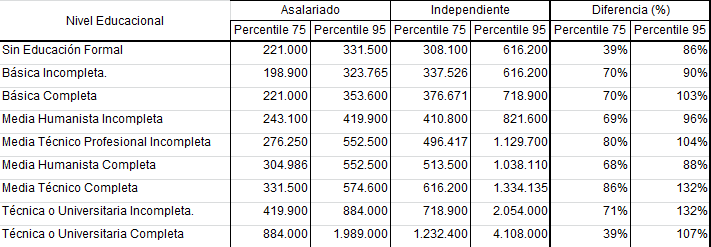In a previous post on the income of the independent compared to the dependent, we mention that the comparison of the averages hid the theme of the variations. In particular, the self-employed had a higher probability to get high income that the dependents (to the same educational level): a person of low educational level had a limit of their income as a dependent that I could overcome as an independent.
Now, why focus on the higher levels? (and for a general analysis of the inequality of the income of independent, one can read the text in this link) in a topic, purely subjective: people tend to think that they have greater capabilities than the average, so that their hopes are not placed so much on the average but you get what you get them ‘going well’ (given that they assume that they are counted in that group). And I have the impression that the self-employed can be a group particularly fond of the above -you need a dose of not less confidence in yourself to dedicate yourself to a job that does not have insured income. In this sense, the expectation that there is a greater possibility of obtaining high income as independent does not cease to be relevant.
In any case, what the data tell us?

Source: MARRY 2009
The data show that the difference in favor of the independent workers, like educational level, is even higher in the percentiles higher in comparison with what was happening in the average. We did the comparison with the 75th percentile (that is, the hope of being in the top quarter of income, the ‘optimism moderate’), and the 95th percentile (which represents the hope of achieving success).
In relation to the 75th percentile we find that the difference between independent and wage earners is located between 70% and 80% in general. The single exception occurs at the extremes of education, where the difference is 30% and considerably lower than the difference in the average. This has to do with the dispersion of the income in these groups: The difference in the medium, while it remains favorable to the independent, is even smaller (and in fact, one can observe that the average income of the self-employed with higher education is higher than the 75th percentile which gives account of a distribution highly uneven for that group). But if you think in the 95th percentile, or is the optimism in higher degree, we find that the differences are even higher, and that, in general, are about double the income of the dependent. In fact, the 95th percentile of the self-employed, no formal education is similar (in fact slightly superior) to the 95th percentile of employees with middle education complete.
In other words, the idea that the difference of the average still does not account for the difference in the maximum levels of income that can be achieved is stimulated with these data. And this is a difference that may be even more relevant for independent.
